Support and compression products
Elset and Elset S
Comfortable, light compression bandaging to support healing
Elset® leg bandages provide compression to help patients heal after leg treatment or surgery. They are made from rayon and covered elastic yarns, which are lightweight but tough, with an open weave that is designed to remain comfortable over long periods. The bandages also have slip and conforming properties that help to maintain compression – even as swelling and oedema reduce. You can choose from a variety of widths to suit your patient’s needs.
Elset ‘S’ is specifically designed for above- and below-the-knee stump bandaging – and provides enough length to enable one-piece compression bandaging over the full leg.
- Effective light compression
- Light, open weave for long-term comfort
- Washable for repeated use
- Elset ‘S’ is 12m long, enough to provide one-piece full-leg bandaging
Further product information
When to use Elset and Elset S
Elset and Elset ‘S’ can be used as a compression bandage to promote healing in:
- Vascular surgery
- General leg surgery
- Orthopedic treatment
- Venous leg ulcers
- Above- and below-the-knee stump bandaging
How to apply Elset and Elset S
Elset bandages are designed to be used in the Charing Cross Four Layer Bandage Technique to treat venous leg ulcers.

 Elset
Elset





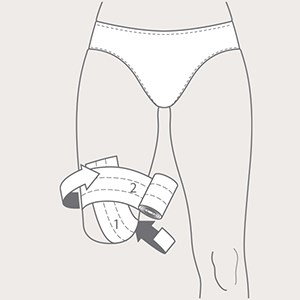 Using an Elset S 15cm width, take the bandage diagonally from the outside of the stump, over the distal end, round the back, and across the front (turns 1 and 2).
Using an Elset S 15cm width, take the bandage diagonally from the outside of the stump, over the distal end, round the back, and across the front (turns 1 and 2).
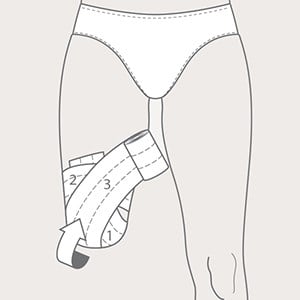 The bandage is now taken round the back and down to the distal end, on the outside, now passing over the front of the stump (turn 3).
The bandage is now taken round the back and down to the distal end, on the outside, now passing over the front of the stump (turn 3).
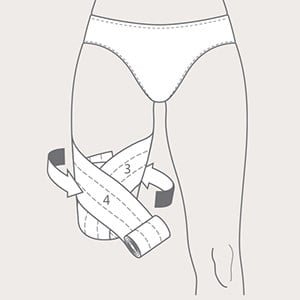 It is again taken around the back and turns 1,2 and 3 repeated as turns 4, 5 and 6, the end of the stump now being completey covered by the bandage.
It is again taken around the back and turns 1,2 and 3 repeated as turns 4, 5 and 6, the end of the stump now being completey covered by the bandage.
 The bandage is taken round the back of the stump to the outside, and diagonally to the distal end, where figure-of-eight turns are commenced.
The bandage is taken round the back of the stump to the outside, and diagonally to the distal end, where figure-of-eight turns are commenced.
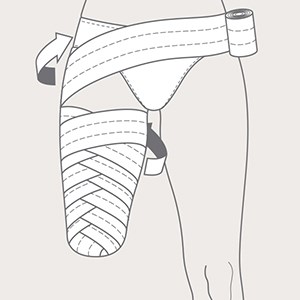 Figure-of-eight turns are continued until the stump is completely covered, a decreasing pressure gradient now being obtained. The bandage is taken high into the groin, preventing an adduction contracture.
Figure-of-eight turns are continued until the stump is completely covered, a decreasing pressure gradient now being obtained. The bandage is taken high into the groin, preventing an adduction contracture.
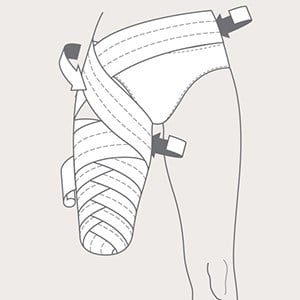 Finally, the bandage is taken over the hip, around the waist and back down over the anterior aspect of the stump. This will prevent an adductor roll. The bandage is now secured on the stump.
Finally, the bandage is taken over the hip, around the waist and back down over the anterior aspect of the stump. This will prevent an adductor roll. The bandage is now secured on the stump.
 Commence bandaging high on the thigh, bring over the distal end of the stump (turn1) and up to just below the gluteal fold. Fold the bandage and bring back to the outside of the stump (turn 2).
Commence bandaging high on the thigh, bring over the distal end of the stump (turn1) and up to just below the gluteal fold. Fold the bandage and bring back to the outside of the stump (turn 2).
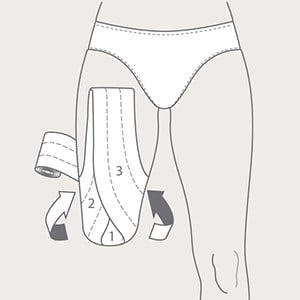 Return to the starting point and fold the bandage, taking it to the inside of the distal end of the stump (turn 3). It is now taken behind to the upper part of the stump, on the outside.
Return to the starting point and fold the bandage, taking it to the inside of the distal end of the stump (turn 3). It is now taken behind to the upper part of the stump, on the outside.
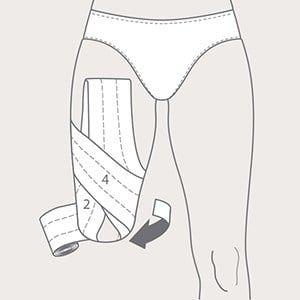 Bring the bandage diagonally across the front of the stump (turn 4) and partially cover turn 3, and around the back to the outside, at the distal end.
Bring the bandage diagonally across the front of the stump (turn 4) and partially cover turn 3, and around the back to the outside, at the distal end.
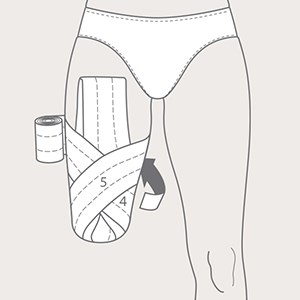 Figures-of-eight are now commenced by passing the bandage diagonally over the front of the stump (turn 5), around the back and returning diagonally to the base of the stump.
Figures-of-eight are now commenced by passing the bandage diagonally over the front of the stump (turn 5), around the back and returning diagonally to the base of the stump.
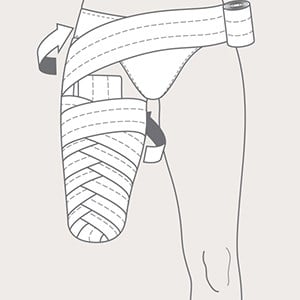 Continue bandaging by adding figure-of-eight and taking it high into the groin and up around the waist to prevent adduction contracture.
Continue bandaging by adding figure-of-eight and taking it high into the groin and up around the waist to prevent adduction contracture.
 Finally, the bandage is taken over the hip, around the waist and back over the anterior aspect of the stump. This will prevent an adductor roll. The bandage is now secured on the stump.
Finally, the bandage is taken over the hip, around the waist and back over the anterior aspect of the stump. This will prevent an adductor roll. The bandage is now secured on the stump.





